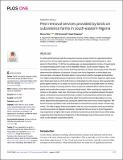Files in this item
Pest-removal services provided by birds on subsistence farms in south-eastern Nigeria
Item metadata
| dc.contributor.author | Tela, Murna | |
| dc.contributor.author | Cresswell, Will | |
| dc.contributor.author | Chapman, Hazel | |
| dc.date.accessioned | 2021-08-10T16:30:08Z | |
| dc.date.available | 2021-08-10T16:30:08Z | |
| dc.date.issued | 2021-08-09 | |
| dc.identifier | 275406761 | |
| dc.identifier | 79cbddc7-1f27-478d-8c67-94c600127fe5 | |
| dc.identifier | 000685266800033 | |
| dc.identifier | 85112263549 | |
| dc.identifier.citation | Tela , M , Cresswell , W & Chapman , H 2021 , ' Pest-removal services provided by birds on subsistence farms in south-eastern Nigeria ' , PLoS ONE , vol. 16 , no. 8 , e0255638 . https://doi.org/10.1371/journal.pone.0255638 | en |
| dc.identifier.issn | 1932-6203 | |
| dc.identifier.other | RIS: urn:8CE91CC24262D4C973F23C922B1A6304 | |
| dc.identifier.other | ORCID: /0000-0002-4684-7624/work/98487654 | |
| dc.identifier.uri | https://hdl.handle.net/10023/23754 | |
| dc.description | Funding: MT was supported by two grants; a studentship funded by New Zealand Ministry of Foreign Affairs and Trade (MFAT) https://www.mfat.govt.nz/, through the University of Canterbury, New Zealand, and A.G Leventis educational research grants for doctoral candidates https://www.leventisscholarships.org/. | en |
| dc.description.abstract | To what extent birds provide the ecosystem service of pest control in subsistence farms, and how this service might depend on retained natural habitats near farmlands is unexplored in West Africa. To fill this knowledge gap, we placed plasticine mimics of insect pests on experimentally grown crops on the Mambilla Plateau, South Eastern Nigeria. We recorded bird attacks on the mimics and the proportion of mimics removed by birds. We also determined the influence of distance of crops from forest fragments on both attack and removal rates. We placed 90 potted plants of groundnut (Arachis hypogea) and bambara nut (Vigna subterranea) along 15 transects running 4.5 km from forest edge into open grassland. Each plant had six of the 540 mimics in total placed on their leaves. We inspected the potted plants weekly for 12 weeks to record (i) the presence of bird beak marks on mimics, and (ii) the number of missing mimics. Once a week we collected all the mimics from the plants and counted the number of assumed beak marks. After counting we replaced the mimics on the plants, mark free. We found a strong positive correlation between the abundance of insectivorous birds and the mean number of missing mimics and/or bird attack marks on mimics. However, this positive effect of insectivorous bird abundance on prey mimic attack/removal became less strong the farther they were from a forest fragment. We found increased predation rates and abundance of insectivorous birds closer to forest fragments. Our data suggest that pest predation may be a key ecosystem service provided by insectivorous birds on Nigerian farmlands. Farmlands that are closer to forest fragments may experience a higher rate of pest control by insectivorous birds than those further away, suggesting that retaining forest fragments in the landscape may enhance pest control services in sub-Saharan subsistence farms. | |
| dc.format.extent | 17 | |
| dc.format.extent | 1536583 | |
| dc.language.iso | eng | |
| dc.relation.ispartof | PLoS ONE | en |
| dc.subject | QH301 Biology | en |
| dc.subject | S Agriculture (General) | en |
| dc.subject | DAS | en |
| dc.subject.lcc | QH301 | en |
| dc.subject.lcc | S1 | en |
| dc.title | Pest-removal services provided by birds on subsistence farms in south-eastern Nigeria | en |
| dc.type | Journal article | en |
| dc.contributor.institution | University of St Andrews. School of Biology | en |
| dc.contributor.institution | University of St Andrews. Centre for Biological Diversity | en |
| dc.contributor.institution | University of St Andrews. Scottish Oceans Institute | en |
| dc.contributor.institution | University of St Andrews. Institute of Behavioural and Neural Sciences | en |
| dc.contributor.institution | University of St Andrews. St Andrews Sustainability Institute | en |
| dc.identifier.doi | https://doi.org/10.1371/journal.pone.0255638 | |
| dc.description.status | Peer reviewed | en |
This item appears in the following Collection(s)
Items in the St Andrews Research Repository are protected by copyright, with all rights reserved, unless otherwise indicated.

